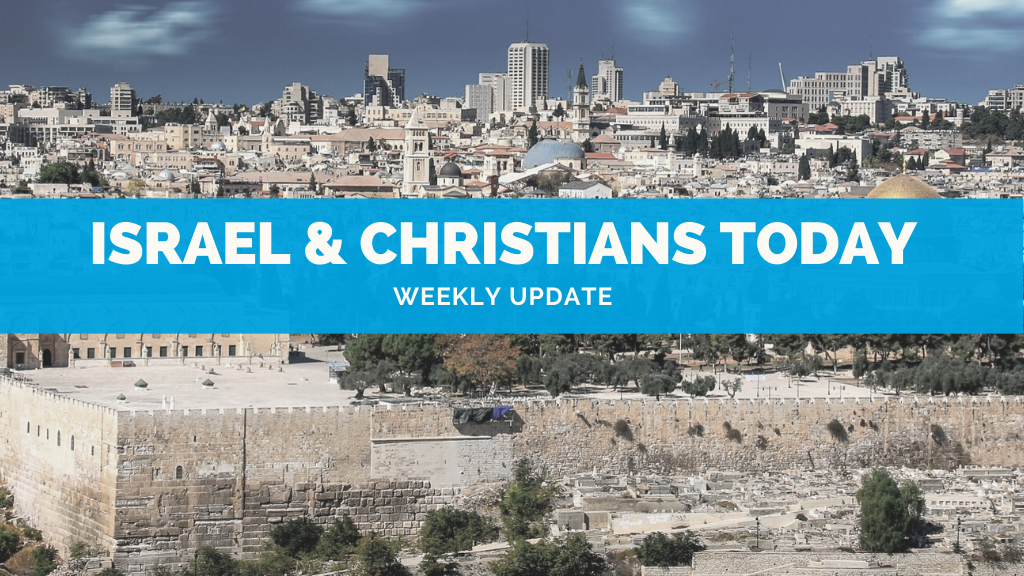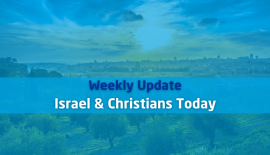Weekly Update: The current violence in Israel – what is happening, and why?
Violence has erupted in Israel. Riots on the Temple Mount, hundreds of rockets from Gaza, Jews and Palestinians killed and wounded. The situation is volatile.
Many in the Western media are portraying Israel as the aggressor, and the Palestinians as victims. But the situation is more complex and nuanced than is often portrayed.
Underlying factors include a deeply emotional dispute about the status of Jerusalem, and whether Israel’s control of the city is justified, as well as the determination of Hamas and its allies to destroy the Jewish State of Israel.
There is no doubt that Hamas and extremist Islamic elements within Palestinian society have been – as often before – preparing and waiting for an opportunity to unleash violence against Jews. Iran is supplying rocks that Hamas fires.
The conflict with Hamas is likely to last days if not weeks.
The Editorial team
The status of “East Jerusalem”
One of the factors underlying the current violence is a strongly-held belief by many that Israel has illegally annexed what is known as “East Jerusalem”, and that the “occupation” must be brought to an end. Israel and the Jewish people consider that Jerusalem is the rightful capital of the State of Israel. Most Arabs believe that East Jerusalem (including the Temple Mount) belong to the Islamic world, and must become capital of a Palestinian state.
Jerusalem was under British control during the Mandate period (1920-1948) and was divided between 1948 and 1967 when Jordan had illegal control of the eastern part of the city. Israel gained control of the whole city of Jerusalem during the Six Day War in June 1967. It immediately reunited the city, and in 1980 it declared the city to be the undivided capital of the State of Israel. This claim has been rejected and condemned by many in the international community.
Under Israeli control, since 1967, all Jewish, Muslim and Christian Holy Sites are protected, and all faiths have freedom of religion and worship, as never before. Freedom under the current Israeli governance can be contrasted with in the last 2000 years when the city has been dominated by Christian and Arab/Islamic empires.
There are strong arguments why Israel is entitled to govern the city.
> Read more..
Sheikh Jarrah
Sheikh Jarrah is a suburb situated in what is known as “East Jerusalem”: that part of Jerusalem that was occupied by Jordan. Several Palestinian families are threatened with eviction from their homes. This has led to protects and violence over the past weeks, which escalated in recent days.
The International Legal Forum explains that the case of Sheikh Jarrah is a complex and long-running matter. It reflects the area’s religious significance and spans a history dating back to the pre-1948 British mandate era. The case has been subject to legal proceedings since 1972 and is currently before Israel’s Supreme Court, where a final decision is expected in the next month.
> Read more..
Violence on the Temple Mount
Background: The Temple Mount is the most important and contentious site in Jerusalem from Jewish and Muslim perspectives. Known as Har HaBayit (Hebrew) or Haram al-Sharif (Arabic), it encompasses the the Western Wall (Kotel), and, on top of the plateau, the Dome of the Rock and the Al-Aqsa Mosque. One week after the end of the Six-Day War, Moshe Dayan, Israel’s Defense Minister, handed control over the Temple Mount to the Muslims and ordered that the Haram al-Sharif be open to all Muslims throughout Israel. Under the Holy Places Law, 5727-1967, administration of non-religious affairs in Jerusalem was effectively placed under Israeli control, while administration of religious affairs was shared between Jewish, Christian and Muslim authorities. In 1967, the administration of the Haram al-Sharif and other Muslim holy sites was placed under the authority of the Islamic Waqf, which currently controls the day-to-day administration, including guards supervising the entrance to the Haram al-Sharif. Under this authority, Muslims have daily access to the Haram al-Sharif and can freely worship there. Yet, the Waqf has restricted the rights of Jews and other non-Muslims by limiting the rights of access and the freedom to worship on the Haram al-Sharif; non-Muslims are only allowed to visit the place at fixed times, they cannot enter the al-Aqsa mosque and they are not allowed to pray on the Haram al-Sharif.
Mass violence on the Temple Mount began on 7th May after Friday prayers. Palestinians threw rocks at Jewish worshippers at the Western Wall, which is located some 20 metres below the Temple Mount platform.
There is considerable evidence that this violence was planned, with rocks and stun grenades prepositioned (images here and here). On the same day, a Hamas spokesperson called on Palestinians to slit the throats of Jews (note: not ‘Israelis’).
After the violence on Friday, there was an explicit call by the Palestinian Authority’s ruling Fatah party to continue the violence on Monday evening, which is what happened.
Israeli police responded to the violence with teargas and rubber bullets, resulting in 200 injuries on Friday.
Al-Aqsa Mosque is an emotional rallying point for many Muslims, and accusations that ‘al-Aqsa is in danger’ in the face of violence (even when instigated by Palestinians) on the Temple Mount will a) rally many Palestinians and b) bring considerable pressure on Israel. The riots of 1929 (in which all Jews were expelled from Hebron) were instigated because of false rumours that al-Aqsa was in danger, as were in the mass riots in 1996, and so on.
Gaza and Hamas
On Monday, in alleged support of Arabs in Jerusalem, Hamas fired over 200 rockets from Gaza. These were aimed at Israeli civilian areas (which is a war crime). And many were fired from civilian areas within Gaza (which is also a war crime). Seven of the rockets were aimed at Jerusalem. Israel’s anti-rocket system has shot down many of these rockets, although some have hit Israeli homes.
On Tuesday, Hamas launched more than 600 rockets. In a new tactic, it launched many rockets at the same time (one of many videos here), in an attempt to overwhelm Israel’s anti-rocket system, Iron Dome.
It is well known that over the last years Iran has been supplying long-range rockets to Hamas, that were smuggled via Sudan, Syria and Sinai.
> Read more…
A “confluence of events”
The Zionist Federation of Australia has summed up the “confluence of events that has led us to this moment”:
Israel’s Supreme Court was due to make its final decision on the Sheikh Jarrah issue, but has delayed the decision until at least 8 June. There have been weekly, low-level protests in Sheikh Jarrah for some time.
Organised and spontaneous Palestinian violence against Israel has been increasing in recent months. These include 40 rockets fired from Gaza into Israel in April, the filming and sharing on social media of random attacks against religious Jews and a fatal drive-by shooting in the West Bank.
In response to the violence on social media, a handful of Jewish Israelis conducted provocative protests in Arab areas (these were stopped by Israeli police)
After the 29 April postponement of the Palestinian parliamentary elections, the Palestinian leadership has sought to deflect criticism by changing the media focus. It has ramped up incitement to violenceagainst Jews since that time. (There is historical precedent of increased incitement to violence leading within weeks to mass violence; two weeks before the second intifada in 2000, a dramatic increase in incitement to violence in Palestinian media was reported)
It is currently Ramadan, a period in which Palestinian nationalist sentiment is usually intensified. 7 May, the first day of mass violence on the Temple Mount, was the last Friday of Ramadan, which always draws a massive crowd for Friday prayers.
Monday was Jerusalem Day, the anniversary of the 1967 capture of the Old City (wherein lies the Temple Mount and Western Wall) by Israeli forces. The day is marked by Israelis marching towards and into the Old City, to gather at the Western Wall plaza. (This year, due to the tension, the route was changed).
The Israeli political system is currently in a state of flux, with the mandate for forming a new (and probably minority) government having been handed to the Opposition Leader.
There are numerous Palestinian parties that want to fight Israel until it is destroyed. These use any pretext to justify organised and popular violence. The Sheikh Jarrah and Temple Mount situations are examples.
All of these factors are interwoven and often act as multiplying agents; it is near impossible to separate out individual factors as ‘the’ reason for the sudden violence.
Scripture for the week: Psalm 122
A song of ascents. Of David.
1 I rejoiced with those who said to me, “Let us go to the house of the Lord.”
2 Our feet are standing in your gates, Jerusalem.
3 Jerusalem is built like a city that is closely compacted together.
4 That is where the tribes go up—the tribes of the Lord—to praise the name of the Lord according to the statute given to Israel.
5 There stand the thrones for judgment, the thrones of the house of David.
6 Pray for the peace of Jerusalem: “May those who love you be secure.
7 May there be peace within your walls and security within your citadels.”
8 For the sake of my family and friends, I will say, “Peace be within you.”
9 For the sake of the house of the Lord our God, I will seek your prosperity.




